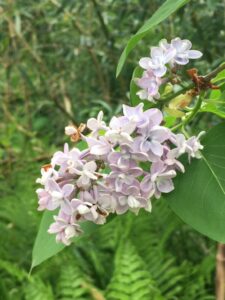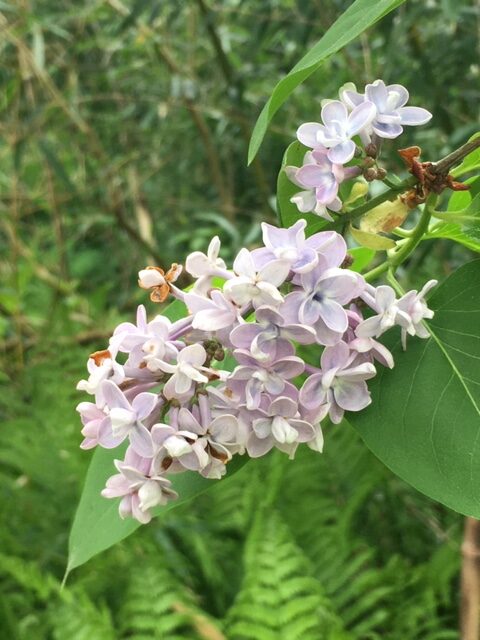May 14th
The 134th Day of the Year
Late Spring keeps the promises of April: mock orange wide open days before peonies, iris and poppies, daisies and the first clematis, meadow goat’s beard and red pyrethrums, ginger and sedum, comfrey and stitchwort, silver olive and the honey locusts flower all the way; strawberries ripen on the high tide of purple rockets and golden buttercups.
bf
Sunrise/set: 5:21/7:42
Day’s Length: 14 hours 21 minutes
Average High/Low: 72/50
Average Temperature: 61
Record High: 89 – 1962
Record Low: 36 – 1920
Weather
The chances of sunshine on the 14th of May are high: a full 80 percent. Rain, however, falls on 35 percent of the days, a ten percent increase over yesterday’s odds. Highs in the 50s are infrequent on the 14th, occurring only once in 15 or 20 years. Temperatures climb to the 60s on 20 percent of the afternoons. Seventies are the most common, coming 45 percent of the time; 80s and 90s round out the spectrum at 25 percent and five percent respectively.
Natural Calendar
Almost all the Midwestern field corn has now been planted in drier years. Half of the soybean and half the sugar beet crops are in the ground, along with two-thirds of the potatoes and a fourth of the tomatoes. Commercial sunflower planting time begins as the chances of a light freeze fall well below five percent. In the salt marshes of the South, fiddler crabs emerge from their tunnels in the creeks and estuaries. Across the Atlantic Ocean in the fields of Great Britain, apple orchards are usually in bloom, bulbous buttercups and bluebells, too.
Daybook
1983: First two comfrey flowers.
1984: Crabapples still holding their petals in this cold spring.
1985: First strawberries for breakfast today. Osage flowers falling, every poppy, sweet rocket, and mock orange open. Blue flag and sweet Cicely fading. Garlic mustard gone and bowing. Full rockets everywhere. Tall meadow rue and angelica buds completely emerged. Wingstem two feet tall. Canopy virtually in place.
1986: First parsnips flower in Dayton. Hummingbird seen at the frog pond along Grinnell Road. Yellow sweet clover, red clover, black medic at Wilberforce.
1987: Very first mock orange opened in the yard today.
1989: Still no poppies, no mock orange, no strawberries.
1990: My nephew John reported his first strawberry blooming in New York Mills, Minnesota, 800 miles north of Yellow Springs, 30 days from the first strawberry bloom here, right on schedule, spring moving north at the rate of approximately 25 miles per day.
1991: First blue flag opens. Tulip tree in bloom at the Covered Bridge. The air sweet with flowers. Honeysuckles falling. Canopy complete.
1993: Bright orange geum starts to open. First comfrey and pyrethrum fully open. First patches of poppies suddenly full bloom along Grinnell Road and Elm Street. Dock heading on Xenia Avenue and along the fields. Lupines fat and blue now, flags budding. Scorpion fly on the window screen this evening. Orchard grass well developed.
1998: First blue flag unravels in the garden.
1999: First orange daylilies open along Grinnell Road. The bridal wreath spirea suddenly declines, honeysuckles and locusts stay at their peak. First blue flag opens. First skipper butterfly seen. Tadpoles discovered hidden in corners and under rocks of the pond. The bathroom suddenly full of huge black flies.
2001: Multiflora roses open in the garden, poison hemlock seen in bloom along the highway to Dayton.
2002: Robins suddenly constantly peeping in the yard. Orienting their young? First spiderwort and columbine bloomed today.
2003: First blue flag iris and stella d’oro lily opened in garden. Bridal wreath spirea almost gone. Snowball viburnum flowers hold. Poppies full bloom in Clifton.
2004: Multiflora roses reach full bloom overnight. In the woods, geese are honking. No insects seen. Waterleaf is blossoming, and the first meadow goat’s beard is open along the path in the butterfly preserve. Late garlic mustard, full sweet rockets, sweet Cicely dominate the fields. Ironweed, jewelweed and wood nettle are past knee high. Poppies and iris flowering all over town, but not in the south garden. Weigela is in bloom now.
2006: The first dark blue spiderwort was open today. Bright red azalea in the east garden holding, but the allium has passed its best, and the late season tulips are almost gone.
2007: Allium strong, azaleas and tulips gone. Mateo’s violet weigela is in full bloom. Star of Bethlehem ends suddenly. Herb plants set into the circle garden.
2008: The perennial blue salvia in the far northwest corner of the garden pulls my view out from the violet hyacinths, the violet flax and the red-violet allium in the circle garden, then back to the pink deadnettle and the pale blue spiderwort between them. The one purple iris to the left, more hyacinths to the right fill my vision. In the alley this morning, all the lilacs were gone, and a small flock of grackles was making a ruckus in someone’s back yard.
2010: Blueberry bushes have two buds. Dutch iris early full, Indian hyacinths all to fat seeds. First daddy longlegs seen, clustered snakeroot blooming, pollen gold, roses and campanulas opening. First peony opens at home, meadow goat’s beard full bloom in town and along the highway south, locusts starting to fall. Multiflora roses coming in.
2011: Long walk in Spoleto around the hills that surround La Rocca. Sunny and mild, light wind. Rondini (swallows) in the valleys, wild fennel all along the paths. Purple wild cyclamen in the hilly shade. Cuckoos and merli sang in the distance. White campion, bladderwort common, spitbugs on a number of plants, several St. John’s wort in full bloom, large late euphorbia on the hillsides, and something similar to blueweed.
2012: Liz wrote again about the black swallowtail: “The butterfly stayed until today…was still here this morning, then gone when I came home from work. Two days of total stillness before setting off on its adventure. A sesshin!”
2013: Goshen, Indiana: Many fields of dandelions still bright, but many also gone to seed. Crab apples mostly gone. Redbuds and dogwoods fading.
2014: At the parking lot near the grocery store, Neysa and I saw one very small gosling with its parents in the grass. One meadow goat’s beard was open by the side of the road.
2015: First dark violet spiderwort bloomed in the north garden. If I had enough rhubarb plants, I could have a pie; the stalks on my only plant are big enough to cut. Wood hyacinths, Korean lilac and allium holding, poppies full in Liz’s garden, and Mateo’s weigela is in full flower (must have come in with the locusts and mock orange and honeysuckles). Creeping phlox in decline downtown. In the North Glen: sweet rockets, catchweed, Solomon’s plume, ragwort, May apple, phlox, watercress, white violets, small yellow sedum. Touch-me-nots knee high.
2016: Large patches of wild daisies along Dayton-Yellow Springs Road, winter wheat tall and mellowing. The yellow climbing rose at Liz’s is in full bloom. My weigela early bloom, starting to anchor the west end of the north garden near the house; Mateo’s weigela loaded with blossoms. Honeysuckle flowers falling in the cold rain. On the steps to the Cascades, wood betony.
2017: The first peony in the yard opened overnight, three more in the afternoon. Weigelas are holding strong. First locust petals starting to fall. At Clifton Gorge, Solomon’s plume (more than I’ve noticed in other walks), waterleaf and white violets are the main plants in bloom. Leafcup is waist high, all the undergrowth lush. A third red admiral butterfly came by the circle garden.
2018: I keep feeling left behind by the speed of spring, and so in this backwater of flowers in which I find myself, confused, surrounded by the full-beautied detritus of the flood of May, I stumble through the woods and garden, picking up pieces, seeing this, seeing that, not knowing where to begin, knowing that it doesn’t matter, knowing that it does. And even though the markers of this time of May are never quite the same from year to year, they are similar enough to offer a kind of stability to my own history and to the history of the landscape and climate, a collection of floral trivia making sense of larger and smaller things.
2019: A walk in North Glen with Jill: the undergrowth lush, wild phlox, waterleaf (Hydrophilum appendiculatum) and wild geraniums common beside the white violets. One red admiral butterfly came by, and I saw a sulphur when I went jogging with Ranger in the early afternoon. At home, the first wisteria flower has unraveled. Dennie sent Jill a video of bees swarming at her farm.
2020: Blue jays calling and calling, fledglings out of the nest. One yellow sulphur butterfly. One common fleabane in bloom. Only a handful of honeysuckle flowers open (a gauge of how cold this spring has been). Pink quince flowers falling to the koi pond. Standard lilacs and Korean lilacs still holding. I went to look for Liz’s yellow rose, but the plant was no longer there. Mosquitoes attacked me on the back porch for the first time this spring. Thunderstorm at 5:15 this afternoon, dark clouds and wind sweeping across the woodlot.
It is Nature’s rutting season. Even as the birds sing tumultuously and glance by with fresh and brilliant plumage, so now is Nature’s grandest voice heard and her sharpest flashes seen. The air has resumed its voice, and the lightning, like a yellow spring flower, illumines the dark banks of the clouds. All the pregnant earth is bursting into life, like a mildew, accompanied with noise and fire and tumult. She comes dripping rain like a cow with overflowing udder.
Henry David Thoreau



Wonderful photo and I enjoyed meandering back through time with you!!
And I enjoy the meanderings with you!